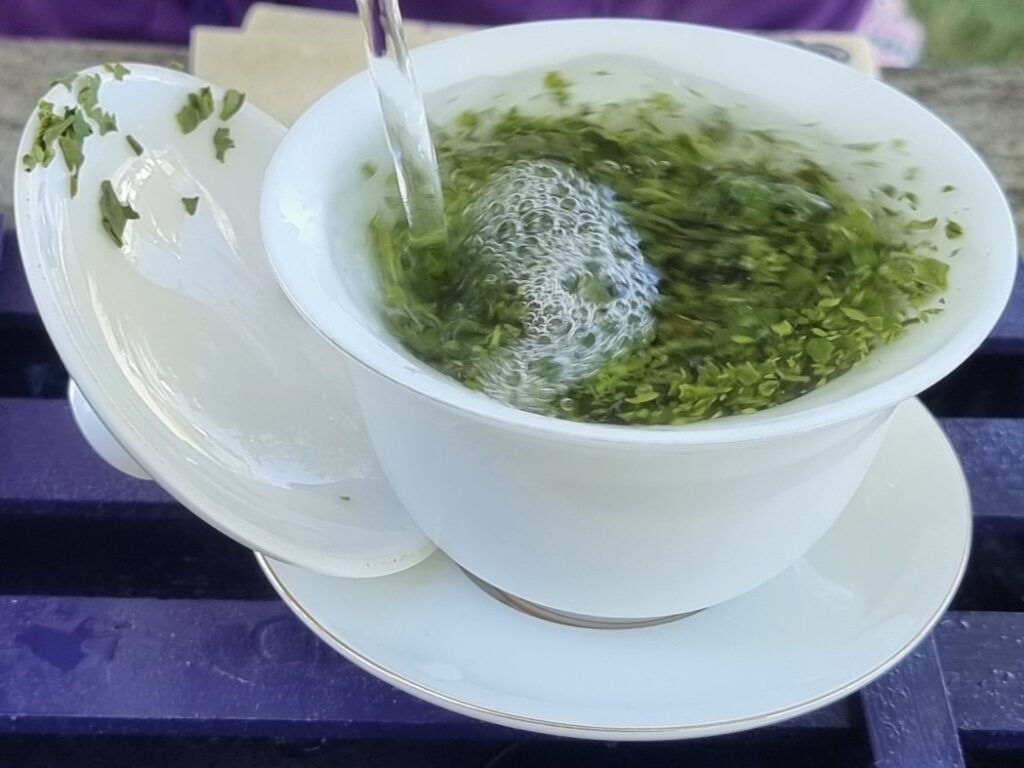I have always wanted to make tea from fresh leaf with my own hands, and have great respect for people who do this and those who have teachings from generations before. Constantly asking questions to my producers and my tea mentor, Nalin. Producers closer to home have also been instrumental in my understanding. Answering any random questions when I was making things up in my kitchen to craft my own green tea.
Taking home just a handful of leaves from Guisachan, resulted in my initial foray into green tea production.
First flush pick happened at the start of May this year, which I ventured out to help with picking. Taking this handful of leaves home to have a play with, I wasn’t sure what would emerge. In hindsight I should have weighed them, the starting fresh weight is anyone’s guess.

As you can see It really wasn’t much.
On hand I had a packet of a Renegade estate green tea. They have a step by step overview on the tea creation steps on the label. I should note that it is not a fully comprehensive guide, nor is it intended to be used as a recipe.
The information given on these labels is a wonderful insight to the tea process, but an instruction manual it is not. To give an example the stages are described like this:
Wither for x hours
Roll for x minutes
Which means that if you don’t know what withering or rolling entails, you need to Google or ask people. Thankfully I already had an idea what these terms meant. All the ambiguous areas, I just had to wing it.
A key stage in green tea is one referred to as kill-green, which comes from the mandarin ‘shaqing’ (killing the green). The aim of kill-green is to stop the tea leaves turning black and locking the green freshness in. Heating changes and stops the enzymes in the leaves which cause the oxidisation reaction over time.
On hand the only suitable equipment for such a tiny volume of leaf was my small pink frying pan. This was the platform for my kill-green attempt.
Armed with a list of worries:
Would this frying pan be hot enough?
Would I know when the kill-green stage was finished?
Would it even stay green?
Drawing from my experience creating black tea where the smell changes over time, I became fixated on noticing any subtle changes in aroma and colour that indicate that oxidation is happening. So blinkered by this, I was oblivious to what was happening to the texture of the leaves.
Due to my blinkered state, I left the tea leaves in for too long in this pink frying pan and had the heat too high. The tea leaves suddenly turned very crispy.
I ended up with three grams of finished dry tea, which did not smell that great. This alone caused me to decide it was a failure! As I had left it too long in the kill green stage, which resulted in the leaf drying out. This had a knock on effect that when I tried rolling the leaves (the next stage) they simply crumbled in my hands!
Yes, there were improvements to be had there. But was it a failure?
To answer this I reached out for advice.
Enter Matt from Jersey Fine Tea who was a key figure, patiently answering my questions.
He helped me understand that there are better ways of creating green tea. Rolling crispy leaves between your hands is not the way forward.
I did not have much hope for this first attempt tasting palatable on any level. Against my better judgement, I took it along to taste with a friend, someone else who also appreciates tea, for a second opinion. I wanted to help this tiny tea batch avoid the inevitable fate of being shamefully hidden and forgotten in the cupboard.

I was ashamed of the aesthetics so avoided documenting it as I’d already decided it was going to be horrible!
Choosing to brew at about 85°c and leaving the leaf to infuse for a while as we felt it might have more characteristics of a Japanese green.
What? It tasted amazing!
This ugly monstrosity offered the memory of a fresh shincha, Japanese first pick green tea. I really wish I’d captured my face when I tasted it, the shock that this horrific thing that I created tasted that good. We both agreed that we’d be impressed if we were served it in any establishment.
Recovering from this shock, we reinfused the leaf for a minute and a half and then for a third time for two minutes. You read that, 3 decent infusions from this tea that taught us to not judge a tea by it’s looks!
In true ADHD brain mode, I found myself deep in a rabbit hole all about tea creation. On resurfacing then spoke with Donald and requested more leaf on my next visit.